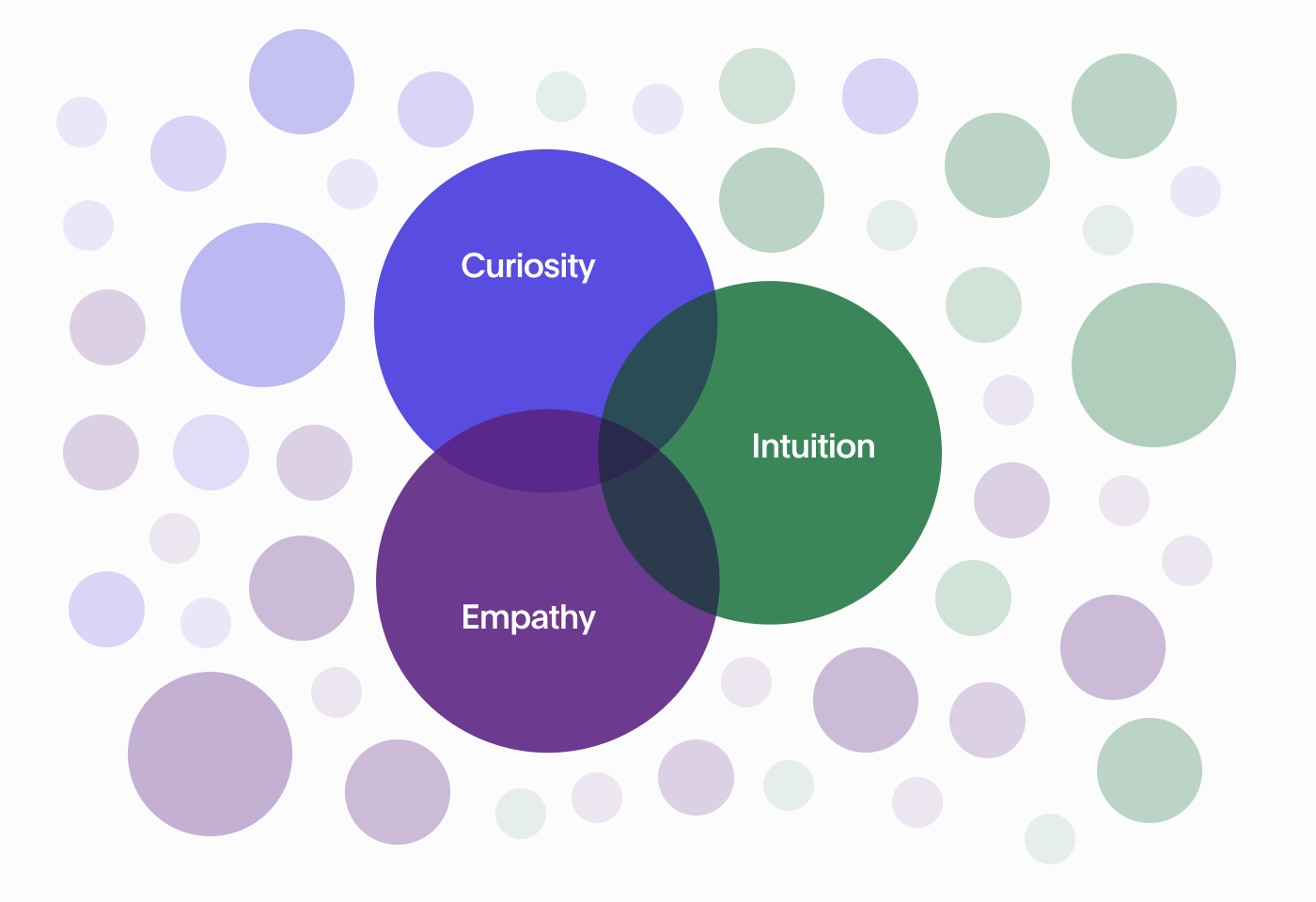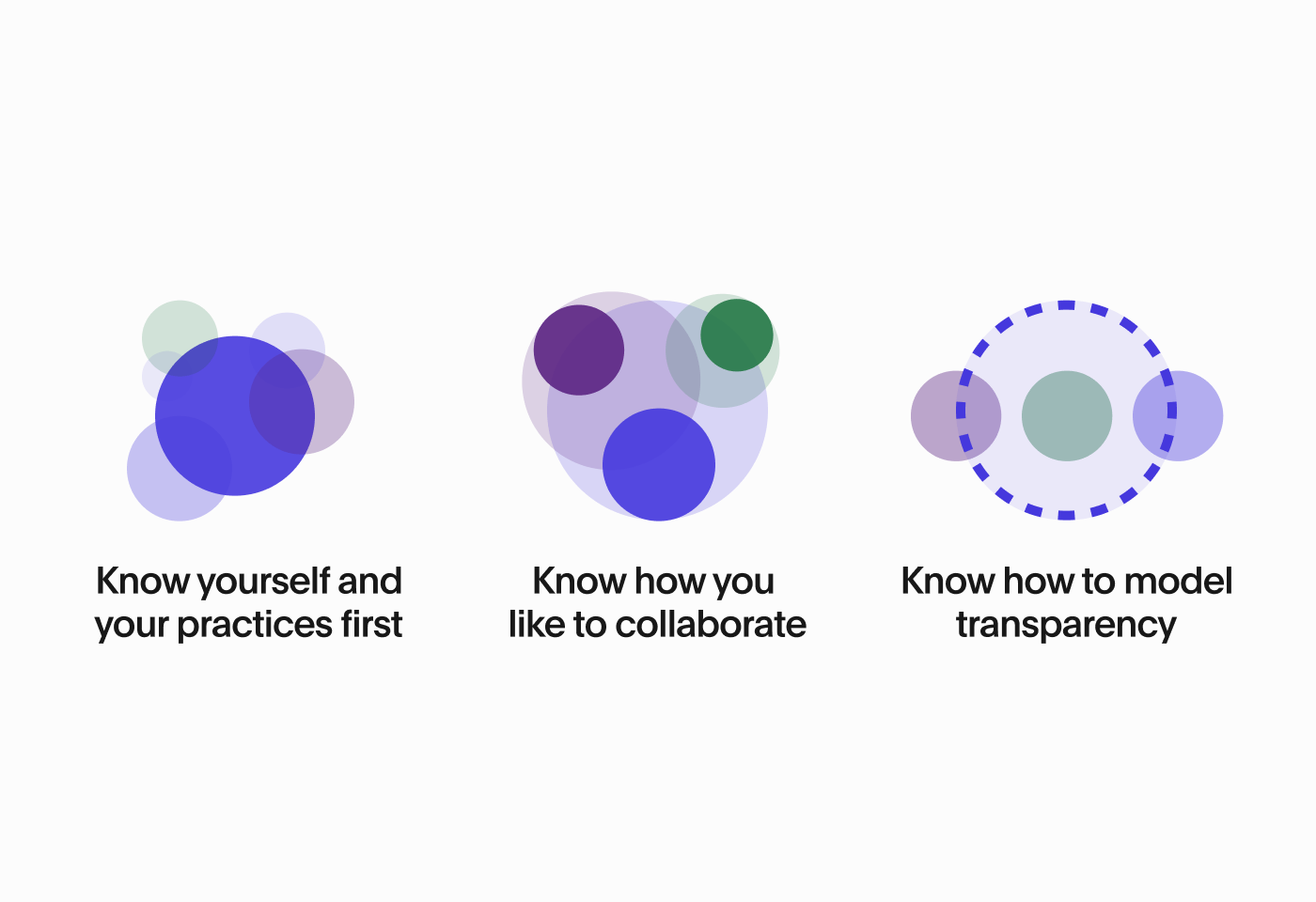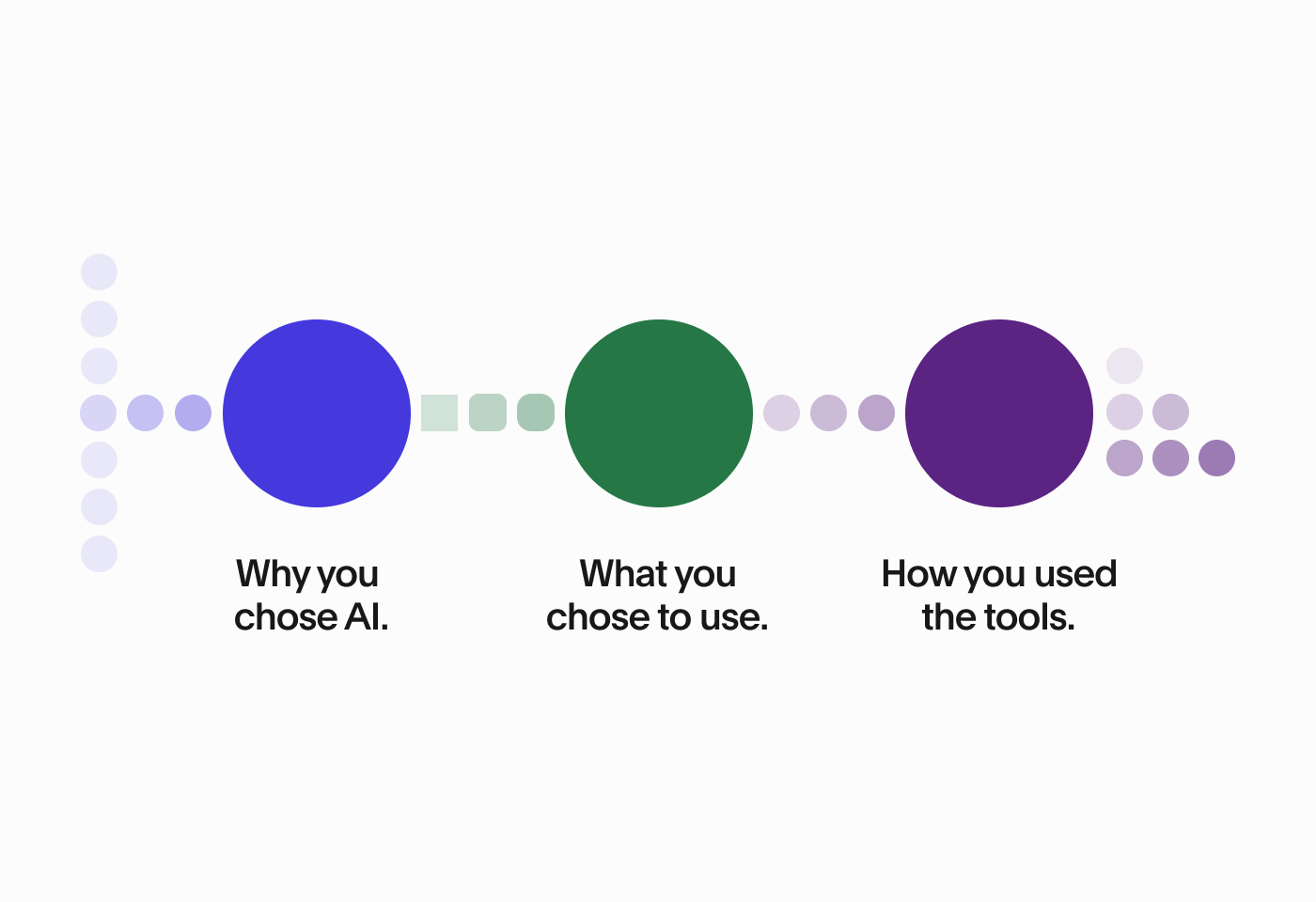Principal Design Strategist Adam Corcoran shares his own reflections and experiments on using AI to be a better designer
As we approach the threshold of widespread adoption of AI tools in our workplaces and personal lives, we’re surrounded by constant headlines predicting that AI will either save us all or end humanity as we know it. Good designers are the best chance we have at safe, ethical adoption of AI.
Good designers hold the practices that champion human needs within complex systems, regularly embracing moments of complexity and ambiguity, and consistently advocating for ethical approaches. This article will show you why good designers are needed, what good designers need to know and how good designers can get started.
*A range of AI tools were used to augment the writing of this article. This article proposes that designers adopt a transparency framework for disclosing AI usage in their processes. Below, I provide an example of this framework in use, using this article as a case study.
Good designers already have what it takes to lead us through AI adoption.
While designers these days come with an endless array of job titles, there are a few critical qualities that all good designers have in common.
Good designers always maintain a balance between curiosity, empathy, and intuition. This mix may look different in various situations, but the essential ingredients are always present.
- Our innate curiosity drives us to ask profound questions, seek deeper meaning, challenge our biases, and experiment and learn from our failures. This natural curiosity makes designers ideal for exploring these new AI tools and raising critical questions about their functionality and impacts on us when we use them.
- Empathy is key in creating inviting and safe spaces for openly discussing challenges and ideas. This leads to profound insights into what motivates, challenges, and enables people. Good designers can wield empathy as they discover and advocate for the human needs that surface during interactions with AI tools.
- Our intuition enables us to develop unconventional ideas by leveraging our innate sense of what is most important to people. This quality makes skilled designers well-equipped to devise innovative and distinct strategies to harness the potential of AI without losing sight of the potential risks involved.
When you combine these qualities, you get someone who can be both a champion for experimentation and innovation and a reminder of the deeply human needs and qualities that must be considered and respected at every turn.

What good designers need to know and how they can translate this into action.
Now that we know why good designers already have what it takes to lead the world through the safe and ethical adoption of AI, the next step is knowing what good designers need to know and how to put this into action. Good designers should advocate for what is right, embrace accountability, and take the necessary steps to lead the way.
"We believe that AI, at its best, is a tool — a digital extension of our collective intellect. While it can process, analyse, and suggest, it is the human touch, the creativity, the understanding, and the empathy, that breathe life into data, turning it into actionable insights and impactful solutions."
Know yourself and your practices first
Design is about understanding people. To be a good designer, you must understand yourself first. With the advent of AI, understanding yourself and your practices becomes even more critical. Rushing ahead to use AI tools without self-awareness is as irresponsible as not understanding yourself in a human-centred design project.
"It doesn't matter how good a designer you are if you don't know who is doing the designing."
Practice regular self-reflection.
Good designers practice regular reflection to achieve self-awareness, personal growth and practice improvement. Reflective practice can be done individually or with a manager's guidance. This piece from Aly Blenkin provides a comprehensive guide. Personally, I’ve been experimenting with Inflection's AI assistant, Pi.ai, as an additional avenue for personal reflection. I chose it due to Inflection’s stance on ethics and safety.
Determine the growth and edges of your practice.
Then, there are our individual and shared practices. These are the approaches, methods and skills we wield in the work. Designers have different strengths and growth areas, and that’s ok. Awareness of these strengths and growth areas is critical to conducting ethical practice. As too is an awareness of the limits of our practices – see this critically important view on the need for a scope of practice from my friend KA McKercher.
"A scope of practice can help us be accountable, say no, grow our skills and notice where we could and should partner with others who know things we don't."
– KA McKercher
Knowing our strengths, growth areas, and limits of our practices is mandatory before attempting to wield AI tools to help us. Otherwise, we risk applying these tools without a critical lens on how they augment and assist our ways of working.
Know how you like to collaborate
AI large language models facilitate dialogue-based interactions, forming a collaborative relationship with the people using them. Good designers need to know how to adapt to various collaboration styles, both in human-to-human and human-to-AI contexts. This means recognising AI as a novel partner in creativity, offering unique ways to engage and innovate.
AI can empower collaboration between people.
Perspective prompting - where the tool can respond to given prompts from several perspectives - can be used to help you practise the facilitation of collaborations where a number of perspectives and communication styles may be present.
AI can help you collaborate with yourself.
AI tools can be a surprisingly useful avenue for self-reflection, personal growth, and creative exploration. A reminder to choose your experiments safely, even when experimenting on yourself. Work to understand the tool and how it works before trusting it with anything private or personal.
AI can be collaborated with as a thought partner.
When experimenting with thought partnership collaborations with AI tools, I’ve had a good amount of success (and almost as many failures). On a recent project to improve a service experience and provide a set of strategic directions, we provided ChatGPT with basic contextual information. Then, we continually added ideas, thoughts and insights to the conversation thread over several weeks. At key moments, we asked ChatGPT for its opinion on which strategic direction to take. Surprisingly, it provided useful reasons for its suggestions, informed by our past thoughts. We never shared raw data from our participants, and the tool never produced a final product we used. However, it unlocked valuable perspectives that triggered breakthrough ideas. (I couldn't find a name for this approach with AI tools, so we could perhaps call it "longitudinal prompting").
Experimentation with various modes of collaboration with AI tools and learning from these experiences is key for any good designer. Especially if we aim to empower others with the knowledge we’ve gained.
Know how to model transparency
Thankfully, as we approach AI adoption at scale, there is no shortage of proposed principles for ethical AI development, adoption and usage. Generally speaking, the proposed principles focus on three key themes: honesty, fairness and safety. For now, let’s focus on the immediate need for honesty and how designers can become models of transparency in the safe and ethical adoption of AI.
Understandably, some people feel that the design industry has not always lived up to its commitment to transparency and honesty. In the past, we've been guilty of using buzzwords and flowery language that can obscure the simple truths of how we work. This can create misunderstandings and feelings of exclusion Good designers cut through this with clarity and transparency. With the adoption of AI in our workflows, there’s no better time to start paying back the debt.
There will surely be future frameworks and practices that emerge for exactly how to do this, but for now (and with apologies to Simon Sinek), I propose a simple “Why? What? How?” disclosure.

A transparency framework for disclosing AI usage in design processes
Why you chose AI.
Designers need to be transparent about their use of AI in their processes. Explain your reasons for integrating AI and how you believe it will be beneficial. Be forthright about any alternative methods you considered, and why you didn't choose them.
Why I used AI in the process of creating this article
The article discusses the responsibility of designers in AI adoption. It calls for designers to experiment on themselves and disclose their methods to others. As the author, I benefited from AI adoption in my workflow and wanted to be transparent about how.
What you chose to use.
Disclose which particular AI tools were used. Include information about the type of AI tool or platform used, the underlying model that it is based on, and your knowledge of its specialisations, its capabilities and its limitations.
Which AI tools I used in the creation of this article
The AI tools selected for supporting the creation of this article were selected based on capability, specialisation and the opportunity for safe experimentation.
- ChatGPT-4, based on OpenAI’s GPT-4 model, was selected as a leading generative AI tool for its capacity to handle large quantities of complex text information and its reliability and accuracy improvements over the previous GPT models.
- Perplexity.ai, based on OpenAI’s GPT-3.5 model, was selected for its ability to extract the most current and relevant information from queries and cite its sources in its responses.
- Consensus.app, based on OpenAI’s GPT-4 model, was selected to surface peer-reviewed academic articles to particular queries and display important information about the article.
- ChatDOC, based on OpenAI’s GPT-3.5 and GPT-4 models, was selected for its ability to intake multiple PDF documents and provide summaries of key information from the group of documents.
- Grammarly AI, based on a proprietary model developed by Grammarly, was selected for its ability to provide writing assistance and adjust and improve tone, content and structure of written outputs.
(Noting, too, that my skillful colleagues provided some of the most valuable reviews and suggestions above and beyond anything these tools did for me).
How you used the tools.
Disclose how the chosen AI tools were used in your processes. Provide information about the techniques and interactions involved in using the tools, the types of data fed into them, and how the responses were interpreted. Share any learnings and mistakes made along the way.
How I used AI tools while creating this article
I used AI tools to help me write this article, but they weren't used to replace my approach. Specific tools were used for specific purposes at specific moments, planned or experimented. I'll provide examples of how each tool was used and links to the full process for those interested.
- ChatGPT-4 was the primary tool used. I shared the article idea, asked it to interview me, used voice mode on the ChatGPT iOS app to respond, and then provided corrective role prompting as needed. Later, I used role prompting and perspective prompting to ask it to surface the important points of the article. Follow this link to see how.
- Perplexity.ai was used for advanced web searches. I asked specific questions about relevant historical events, cultural developments, complex technological concepts and emerging ethical frameworks. I viewed the provided source links directly to dive deeper into specific concepts. Here is an example search that I used in the creation of the article.
- Consensus.app was used to help me understand any current research into the role of designers and their responsibilities in the advent of AI adoption. Due to the low number of cited results returned, I realised the need for writing the article!
- ChatDoc was used to help me compile and interrogate a range of published documents that were important to the article’s contents. With ChatGPT’s new “mention a GPT” feature, I could do this within the conversation about the article already in place with ChatGPT-4.
I hope you found this framework and the example of this article as a case study for how to use it valuable. It’s a nascent idea, and I’d love to hear your thoughts on it – whether you’ve used it yourself, adapted it, used a different approach or have views about whether or not it is necessary. Feel free to email me with any questions, feedback or ideas at design@portable.com.au.

Good designers, it’s time to lead
I’ve been a designer of some form for nearly two decades, and I’ve never known a more exciting and critical time to be in this role. While a world of AI might at first glance look like a world of algorithms and data models for technologists, entrepreneurs and data scientists, it is as much a world requiring champions for deeply human qualities – in how we consider each other, our interactions with the technology, and the implications of its widespread adoption and use.
“I want to caution against any idea that these will bring additional efficiencies to the thinking of designers in the world. In fact, the opposite is true. I have found that when I try to take shortcuts or use tools to augment my work, it often ends up costing me more time. Sometimes the response I need is time-critical, and in that case, these tools have a long way to go before they're going to be able to make any efficiencies here. I would say that good design always takes time and human thinking. When either is in short supply, you can’t call it ‘design’.”
– Me, from my interview for this article with ChatGPT.
The world is asking for entrusted guides to navigate the tensions between complexity and usefulness, obscurity and transparency, suspicion and trust, risk and reward.
The world needs curious, empathetic and creative people who have done the work to understand themselves, to conduct informed experiments and collaborations with AI tools and to be models of transparency in sharing what they’ve learned.
The world needs good designers more than it ever has before.